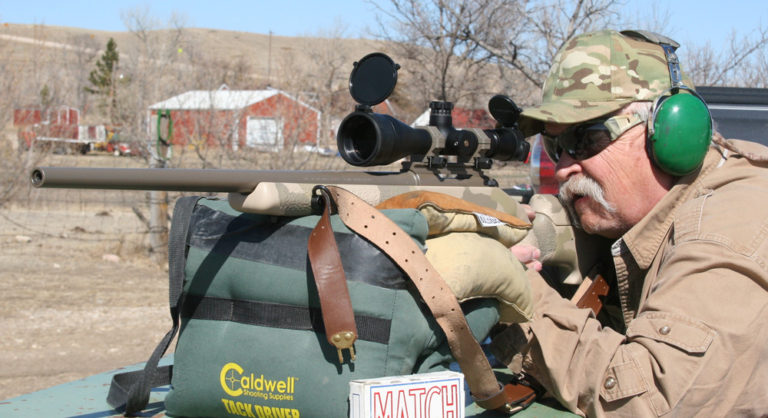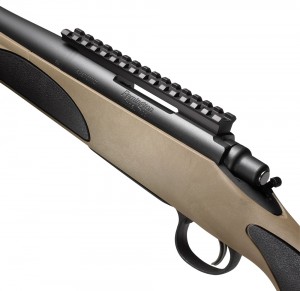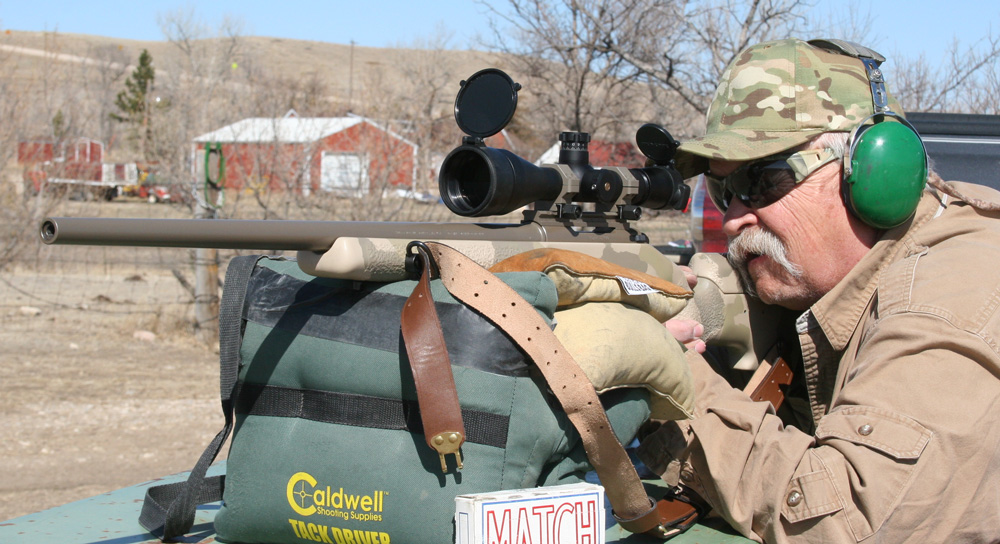
The long-range rifle is generally a bit heavier than its thin-barreled, “pencil-piped” cousin, mounts a stock that won’t warp or twist with humidity or rough field use, carries a well-designed and tuned trigger, and retains a bedding system for the action that makes use of milled aircraft aluminum or glass.
The barrels of these rifles are “twist-tuned,” meaning the rate of rifling twist down every inch of the barrel is matched to specific bullet weights, and the actions are better tuned (at least to some degree), to hold the cartridge case in alignment with the rifle’s chamber. These are key points in gaining good accuracy from a rifle, and, today, a plethora of over-the-counter rifles in their factory boxes, untouched and uncustomized, can produce some outstanding accuracy of a degree not often seen in those early years of long-range rifle production.

As an example of just what even a very standard out-of-the-box rifle—one not specifically designed for long-range work—can do when married even to a lightweight cartridge, a hunt that made use of the.223 Remington LV comes to mind. This rifle, described by Remington as a Light Varmint (LV) model, mounts a fluted stainless steel barrel, a short-stroke 700 pillar bedded action, and a scaled-down synthetic varmint stock. It is drilled and tapped for mounting a scope (no iron sights).
Hunting in Colorado, well west of Denver and the Front Range of the Rockies, I was paired up with a group of scope manufacturers and bullet makers, all of us sitting hip deep in prairie dogs or, as I call them, “grass rats.” Using a heavy but portable benchrest that featured a fully adjustable fore-end rest with sand bags, I set up the light rifle for shots across a wide valley. Rick Payne, a Pentax optics sales supervisor, was acting as my spotter and ranging helper. Rick was well versed in the business of taking long-range pokes at grass rats and, as such, came back quickly with an exacting range of 587 yards to my first target.
What I’m not about to tell you is that I simply adjusted my sights and plunked off the fur ball on the far ridge. No, this was an exercise in artillery school shooting. As I shot several rounds, Rick spotted my impact points and returned information so that I could make the required sight adjustments and walk in the bullets to the unsuspecting critter. Start to finish it took three tries. With the third round downrange, a Hornady V-Max 55-grain pill, the prairie dog rolled off the mound, a small cloud of dust echoing the bullet impact.
To get to that third shot, I had adjusted my Pentax target scope to the second Mil dot and pushed about a dog’s body width away to the right of the animal. There was a slight crosswind of about five to seven miles an hour, and with that wind coupled with the high elevation and warm air, I knew my little .223 Remington load had more going for it up there than what would normally have been the case at sea level. Anyway, once I was there I was set. With the first kill confirmed by Rick, I simply moved to the right and promptly dusted off two rats back-to-back, not with the artillery school tries of the first, but rather with one-shot, dead-on hits.

In reality, the little lightweight, lower-tech “walking” rifle was taking on work designed for much heavier guns with much bigger cartridges. For the most part, the .223 Remington is designed for work to about 300 yards. However, in the hands of a shooter who knows the cartridge, or by way of a good second man spotter, this little varmint/military round can be pushed far.
Of course, not everyone wants to push a rifle into work it’s not really made for. For them, specialized rifles paired with cartridges for long-range shooting are available as both over-the-counter, factory-built guns or as customized offerings. Really, you have a buyer’s market out there, if you want to get into a dedicated long-range shooting rig.
Remington is just about king of the hill, when it comes to factory-packaged, long-range critter-control rigs. I shoot a pair of Model 700 Varmint Synthetic (VS) rifles. The first is in .22-250 Remington, while the second is chambered in .243 Winchester. These rifles are exactly the same, save for the caliber difference. They both use HS Precision varmint/target stocks that retain aluminum pillar bedding, have medium-weight varmint barrels, and good, crisp, gunsmith-tuned 2¾-pound triggers.
Both rifles mount Redfield bases and rings, one with a Weaver 4-16x, the other a Simmons 4.5-14x tubes, with sniper Mil dot elevation and windage correction indicators. Accuracy with both rifles is sub-MOA at 100 yards, with good handloads punching one rough hole in the paper.
Remington offers the Model 700 Sendero SF in the heavy .300 Winchester Magnum cartridge, which is very popular with our military snipers doing long-range work in Afghanistan and Iraq. This rifle is also offered in 7mm Remington Magnum and 7mm Remington Ultra Magnum. Move off that mark a bit and the Remington Model 700 VSF (Varmint Synthetic Fluted) can be obtained in the 7.62x51mm NATO (.308 Winchester) cartridge. It doesn’t stop there.
According to its website, Remington now has more than a dozen centerfire rifles dedicated to varmint and tactical long-range use, everything from the rather plain-Jane but highly accurate 700 SPS Tactical on up to the highly specialized SPS Tactical AAC-SD (designed to be used with an AAC or similarly threaded suppressor), and the super souped-up 700 Tactical Chassis.

Of course, Remington isn’t the only maker of long-range rifles. Take, for instance, Ruger’s Hawkeye Varmint Target Rifle. In cartridges ranging from .204 Ruger and .308 Win. to the increasingly popular 6.5 Creedmoor, Ruger’s VTR includes a very nice two-stage trigger that has a crisp let-off. This rifle also has a barrel that is stainless steel, hammer forged, and target crowned. Add the laminated wood stock and you have an accurate shooting platform for sending long-range pills across fields of prairie dogs or incoming coyotes.
I entered the long-range club via the Varmint Hunters Association years ago by way of a Ruger MK II chambered in .25-06 Remington. Shooting a handloaded 87-grain Speer TNT, I dusted off a grass rat at 527 yards with my first shot.
From the .22-250 Remington, .220 Swift, and .25-06 Remington through the .308 Winchester, this rifle can cover all the bases with the exception of the ultra long-range powerhouse offerings. In other words, if you want a solid 600-yard shooter or more, Ruger can get it done with the best of them.
Another excellent rifle on my list, and by no means the last, is the Savage Arms Model 12 Varmint. Here again, value for the dollar is right up front. Savage has designed accurate rifles that won’ t kill the budget. These rifles use the AccuTrigger, which can be adjusted from 1½ to three pounds in complete safety. The system uses a double release shoe that is failsafe, in terms of an unintentional discharge.
Savage’s Model 12 VLP DPM will chamber the heavy long-range cartridges such as the .300 WSM and the .308. Move to still other hard-hitting rounds and a half-dozen variations in the Target Rifle Series, and you can choose from 6 Norma BR or .308 in something like the Bench Rest model, the 6.5 Creedmoor in the Long Range Precision variant, or the .308 Palma in the Palma model.
These are some serious long-distance firearms. Savage is known to build some of the most accurate and modestly priced rifles on the market today. I have suggested these rifles to many beginning varmint/long-range shooters, with some very pleased shooters coming to the forefront after they give these rifles a try.
I could go on and on with brand names of relatively affordable, out-of-the-box rifles, but the fact is that today it is a buyer’s market out there and the competition for your business in the big rifle department seems to have no upper limit. Just a quick glance at the sheer number of rifles dedicated to varmint and long-range use on almost any big-name website will tell you that. Your biggest chore will be wading through all that’s out there and picking the one that suits your needs best.

Next Step: Get your FREE Printable Target Pack
Enhance your shooting precision with our 62 MOA Targets, perfect for rifles and handguns. Crafted in collaboration with Storm Tactical for accuracy and versatility.
Subscribe to the Gun Digest email newsletter and get your downloadable target pack sent straight to your inbox. Stay updated with the latest firearms info in the industry.








While I agree with the prior 2 posts that, in general, accurate rifles don´t come out of the box, I don´t think that is always true. It seems that the good manufacturers these days can make an accurate factory rifle – they just can´t do it consistently. So, what you have when shopping for a truly accurate rifle out of the box is a situation akin to gambling in Vegas, except that the prize is much more interesting than mere money (to us gun lovers, anyway).
Case in point – I have a Remington 700ADL sporter rifle, unmodified, that will regularly shoot sub-MOA (heck, even sub-1/2 MOA) 3 shot/100yd groups, with handloads. It´s best group to date measured .294″. Note, too, that this is most certainly not a heavy-barreled varmint or target rifle, just a run-of-the-mill M700 hunting rifle. Not a “target” caliber, either – it´s a .30-06. In fact, it´s an older model I bought off a used-gun rack (I swear), without even the new “improved” trigger. (I agree – the old trigger is better.)
So, accurate “factory stock” rifles do seem to exist, but I don´t doubt they may be rarer than we might hope. The author, certainly, does not make this point, but rather implies you can buy a tack-driver any day of the week in any Wal-Mart. Hmmm…anybody care to make a bet?
I bought a Savage model 10 FCP in 7.62×51. Even though I had purchased it with the company’s highly touted “Accustock,” I went ahead and had a custom stock made for it by Fred Moreo out of Delphos, OH. His company is called Sharp Shooter Supply and specialize in Savage Arms. Although his turn around time is not very good, they made the stock and Fred timed and trued the action for me. It’s a tack driver out to whatever distance I feel froggy enough to shoot at. With one of Bushnell’s high end scopes (their Elite Series, front focal planes), the rifle was finally ready for the field, but it now had almost $3000 in it, together with original purchase price. I also had to work up loads for it. The point is, no out-of-the-box rifle is as good a shooter as a rifle that has either been custom built or highly modified, no matter what the manufacturer says. Fred’s website is https://sharpshootersupply.com/ Just remember, their customer service is often quite slow, to say the least, but he is among the very best on Savage rifles.
Genuinely ACCURATE tactical rifles do not come out of a box, let alone one containing a Ruger #1. Cammy paint doesn’t indicate any level of performance. If you want something that will work be prepared to spend 2k or more, sorry guys, the good stuff aint cheap. Recently purchased a Rem 700 SPS with the “micro magix X” trigger or whatever they call it. Total piece of crap designed by a lawyer, the orig rem 700 trigger was great and could be professionally set up for most tactical work. The new rifle is going to my rifle builder today to have the trigger switched out for a Jewell, about 1/3 the cost of the rifle. A Krieger/Hart/Bartlein etc. bbl will set u back 3-400 bucks, there is a reason for that. A good tactical stock will run at least 4-500 bucks and then it should be professionally bedded for another 2 hundred or so.
I love my Ford F150 but it is in no way a Ferrari 458, even if i painted it Ferrari red…
Not trying to be snarky, but facts are stubborn things and ty for your forbearance…
So come one guys, i know u have to tout things to make ur advertisers happy but this article is seriously lacking.